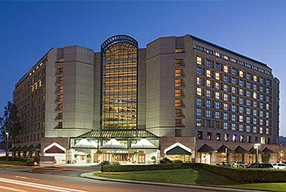EIFS
Synthetic Stucco Systems (EIFS and DEFS)
Synthetic stucco wall cladding products are marketed as proprietary "systems" by individual manufacturers. These systems alone are not complete weather envelopes for buildings. They are themselves only components of a complete weather envelope, that must be joined together into a complete envelope with other non-proprietary components that together can provide weatherproof integrity for the structure. In the construction industry, there is widespread misunderstanding about the weatherproof envelope, and about how weatherproof integrity is achieved and maintained over time. This misunderstanding among practitioners in the design and construction industry has resulted in defect claims involving synthetic stucco clad buildings.
Manufacturers of synthetic wall cladding materials refer to their wall cladding products as "systems" which is the "S" in EIFS and DEFS. These systems are actually building materials for exterior walls, intended to be incorporated with other building materials or products into an exterior wall assembly fabricated by others in the field. Unlike most other wall cladding materials or products (siding, brick, windows and doors, etc.), the synthetic stucco systems that go on the building are actually created in the field, in place, again, by others.
In contemplating these systems, either before their use, as in the design or selection stage, or after their use, as in problem analysis, it is important to gain a clear definition of any given system, and its limits–where the manufacturer's system starts and stops, and where the other components in the wall assembly begin.
A designer's or builder's prerogatives and responsibilities in creating the wall assembly may not be clear without a clear definition of what comprises the system. In defect claims, a clear definition of the system underlies the determination of responsibility for any defects and resulting damages. In the list below, those elements comprising a given system are included in numbers 1 and 2. The others are related to, but fall outside of the system.
When analyzing problems with exterior walls composed of synthetic stucco it is therefore very important to identify, differentiate, and separately evaluate six distinct aspects of such installations:
1. The system's constituent products and materials themselves–any given EIFS or DEFS system is composed of many products from a number of manufacturers. These are referred to herein as "constituent components," and include insulation board, coatings, reinforcing mesh, adhesives or attachment devices, and trim accessories, among others. Generally, the "system manufacturer" either manufactures, or collects from other manufacturers all the constituent components outboard of the substrate, less the sealants and related materials, and markets them as a "system" under its own name. A given manufacturer's product line will have a number of systems with varying characteristics for different applications.
2. The manner in which these constituent components were intended by the system manufacturer to be combined or integrated with one another to create its system, the finished wall cladding material suitable to be used on the outside of a building. This includes how the system manufacturer directs, recommends, or requires the individual constituent components to be joined, embedded in, adhered to, or combined with each other by the applicator in the field.
3. The ancillary materials, products, or systems envisioned, planned, or intended by the system manufacturer be used along with its system in the wall, these include the substrate, the sealants, backer rods, sealant primers, wall framing, flashing's, and the like.
4. The manner in which the system, the finished wall cladding material was intended, proposed, or foreseen by that system manufacturer to be joined with the ancillary products or systems to comprise a complete functioning weatherproof enclosure for a building. These generally include the architectural details provided by the manufacturer, describing how the manufacturer recommends its system be used in a building.
5. The manner in which the complete weatherproof enclosure was intended to be constructed by the A/E, or the building designer or builder. This would be defined in the construction drawings and specifications. One of the reasons this material is involved in many defect claims in residential work is that builders' or developers' residential construction drawings are inadequately or improperly detailed regarding the weather envelope and especially window and door conditions.
6. The degree to which all of the above intentions, plans, directions, recommendations, and specifications were actually implemented, incorporated, or followed in the field by the contractors and applicators. Again, in residential work, there is generally a woeful lack of attentive field supervision.
As can be seen from the above, for any given breach in the weather envelope of a building clad in synthetic stucco, there are many possible reasons for the breach or failure. In evaluating problems in such buildings, and particularly in defect claims, each possibility must be examined.


